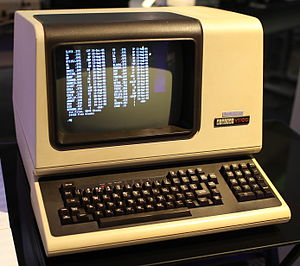Terminal Shell Sed
30 Nov 2019 • Leave CommentsI was aimed to be an ICT expertise. However, still today, I don't quite get the basics of ICT origin. This post will help clarify the relations between Terminal, Shell and Sed.
This is long story. Let's begin with Terminal. At the very beginning, the only interface with the giant (as big as a house) computer was punched tape along with an human being operator. Afterwards, terminal was created allowing individuals to interact with computer. Terminal is a physical device like the following one:

Usually a computer allows multiple terminals online. Each terminal is connected to input devices (e.g. keyboard) and output devices (e.g. monitor screen). Hence, a terminal is more like a serial interface/port between the computer and its peripheral devices. Sometimes, we call the physical terminal as console.
As time flies, standalone terminals were outdated and virtual terminal emerged with smaller computer - Personal Compuer (PC). PC has only one screen and one keyboard embedded but allows switching (Ctrl-Alt-Fn) between multiple (6 by default, vt1 - vt6) virtual terminals. Each virtual terminal has a kernel device (/dev/tty1-6) that provides a means of input and output. It is a software terminal instead of a physical one. Most often, a virtual terminal has a login manager in front before an account can interact with his default login shell (i.e. POSIX Bash).
Apart from virtual terminal, we have terminal emulator when X window presents. Terminal emulator is similar to a virtual terminal but managed by an X server instead of directly by the kernel.
We also have pseudo terminal (pts/xy) that is created and owned by a applications like sshd, terminal emulator (e.g. xterm) etc. A pseudo terminal is a device (e.g. file /dev/pts/04), actually consisting of the master side and the slave side, though they appear to a single device name.
When we ssh to a remote server, we establish a secure TCP connection to the remote sshd daemon. We run a remote application through SSH, by default, which is a Shell like /bin/bash if we does not explicitly provide a command. The remote application needs a terminal for I/O, like STDIN/STDOUT/STDERR. So sshd creates a pseudo terminal for the application (e.g. Bash). sshd is associated with the master, while the remote application is associated with the slave. Here is simple data flow:
| local | Internet | remote |
| | | |
| terminal --- ssh | --------------------------- | sshd - master -- slave - bash |
| | | |
| | | |
After that, ssh/sshd transfer data between local terminal and remote pseudo terminal. Without the slave, how would the Bash process get its STDIN/STDOUT/STDERR? Similarly, terminal emulator (e.g. xterm) also creates pseudo terminal upon startup. The emulator connects to the master side while user processes connect to the slave side. The local terminal above probably is a pseudo terminal of terminal emulator nowadays.
Sometimes you may hear of "attach STDIN/STDOUT" (like docker attach). It actually means creating a pipe between local terminal (e.g. xterm) and the remote terminal (e.g. docker container).
Now let's move on to Shell. Terminal is where input and output happen (like typing program names), but Shell is a job manager (desktop manager does the same thing). Nowadays, OS (Linux, Unix etc.) schedules multiple processes concurrently, namely mutli-tasking support. Shell is the multi-tasking interface with end users, capable of starting, stopping, suspending, resuming etc. jobs. Upon login, the default Shell is ready for interaction.
With Shell, we can suspend the current job to background with Ctrl-Z. On the contratry, fg put the first background job foreground running again. Alternatively, bg send the job running background instead of suspending it. To start a program running in background, we can append & to program like program-name &. Different Shells may have different syntax to manage jobs.
Job is distinct from process, but both of them relate to program. A program is a static executable binary while a process is a running program. Job is only meaningful to Shell. Jobs refer to a pipeline of processes that run interactively. For example, ls | head launches two processes but the pipeline defines a single job. Therefore, a job of Shell corresponds to a process group of OS. Shell assign each job a job ID apart from process PID assigned by the OS. To list existing jobs, just run jobs -l like:
user@tux ~ $ sleep 300 &
[1] 21810
user@tux ~ $ sleep 301 &
[2] 21811
user@tux ~ $ sleep 302 &
[3] 21812
user@tux ~/workspace/outsinre.github.com $ jobs -l
[1] 21810 Running sleep 300 &
[2]- 21811 Running sleep 301 &
[3]+ 21812 Running sleep 302 &
Numbers in brackets are job IDs while numbers that follow job IDs are PID. More about job control, please refer to Manual 7.1 Job Control Basics .
BTW, a daemon does not belong to job as it _detach_es from Shell and gets out of Shell management. Process suspended or running in background belong to job. Putting a job background allows starting another job as the Shell is _release_d.
Finally, we go to sed. It is just a sample of the many programs managed by Shell. Nothing more required to clarify.
Refer to the TTY demystified and Using pseudo-terminals (pty) to control interactive programs.